
Wine Culture and Information since 2002 - Volume 22
 Wine Culture and Information since 2002 - Volume 22 |
|
Mature White WinesWhites are usually considered as wines to be consumed within the first years of their life, a custom that in some cases should be forgotten in favor of waiting |
|
Whites are generally considered as wines to be consumed within two or three years from harvesting. In general terms, this corresponds to the truth, either because white wines do not have the longevity of red wines, as well as because they are usually produced with the specific goal of being consumed in a short time. In other words, the producers themselves - for marketing reasons - produce white wines to be ready and consumed within few months from harvesting. This also corresponds to - like to say - an economic need: it is wished the wine produced in a specific year will all be sold before the beginning of the next one, either to ensure an immediate profit, as well as to ensure the profit of the next year. Therefore, wine produced for an immediate consumption must be sold within the same year, as the next year no one will be interested in that wine anymore - everyone looking for new wines - while condemning the old ones to remain unsold and to their quick decay. The shortening of longevity of white wines is a relatively recent trend, something which condemned them - in general terms - to a life span of two or three years, after that, begins a quick and inexorable decay. In many ancient books, there are countless examples of white wines renowned for their longevity and quality, a characteristic - it should be said - not lost nowadays. A white wine, in order to properly last and age for years, must be produced for this specific goal. There are many examples, even though their percentage is evidently low than the whites destined to an immediate consumption. The few producers who work to the creation of white wines capable of successfully aging for many years, must necessarily face higher costs, as well as the common culture associated to these wines, that is seen as products to be consumed as soon as possible. It should be said not all the grapes are suited for the production of white wines capable of standing to long aging times in bottle. There are grapes having a well known reputation in making wines suited for long aging - the most famous one certainly is Riesling - whereas there are others which have shown to not have proper quality and hardly can go beyond two or three years. These grapes suited for the production of wines destined to an immediate consumption, can however be helped by mean of technology or chemical substances - therefore allowing them to live few years more in the bottle. Saved some very few exceptional cases, the longevity of white wines cannot compete with red or sweet wines. On this regard, it should be noticed that, despite red wines are usually considered suited for long aging, also in this case the wine must be produced for specific goal.
Longevity of white wines, of those who can stand to a long time of aging, that is expressly produced for this purpose, is quite variable. There are wines which can express the best of their organoleptic evolution after six or seven years, while others can also go beyond ten years and more. White wines destined to the aging in bottle, when tasted within their first years of life, do not have a truly amazing organoleptic profile, sometimes being even unbalanced, however showing a quality higher than wines destined to an immediate consumption. White wines are however more fragile than red wines or sweet wines, therefore, in case you are thinking about aging these wines “at home”, you must provide very strict keeping conditions. In particular, you should make sure to not stress the bottle with excessive temperature changes as well as making sure the cork perfectly seals the neck, as the effect of oxygen is - in this case - lethal. The effect of oxygen is however useful for the aging of wines, not only white wines. The positive effect of oxygen is obtained when the exchange with the internal part of the bottle is expressed in very low quantity, almost infinitesimal, an exchange obtained through the pores of cork. What makes the wine to stand to time, in order to develop its organoleptic qualities, is the type and quantity of element contained in it. There are many elements that - in theory - allow a white wine to evolve for many years, although many of them are found in pretty neglectfully quantity, therefore limiting, as a matter of fact, its longevity. These elements are however found in red wines and represent, like to say, the secret of their longevity. The most important ones are the so called polyphenols, commonly defined as tannins, that in white wines are found in pretty low quantity, however not completely absent. Even though they are found in low quantity, when compared to red wines, tannins in white wine can be increased with specific wine making techniques. The most common way is to ferment, and later age, the wine in wood containers, while considering the quantity of tannins added to the wine is higher in case of the use of barrique than of large casks. The aging and fermentation of white wine in barrels favor the effect of oxygen - reaching the inside through the pores of wood - therefore favoring, by means of oxidation, the evolution of wine. Tannins can also be added, a practice getting more and more common, in particular, in the so called “zero sulfites” wine making, that is done without adding any sulphur dioxide. Another method to add tannins to white wine is represented by the maceration of the must with skins - which, besides giving aromas to the wine, they also contain polyphenols and tannins - an operation that can be done before or during fermentation. Polyphenols, despite they are important for the longevity of wines, are however found in white wines in pretty low quantity than reds. Their contribution in white wines is therefore marginal - although significant - and there are other conditions ensuring a long life to these wines. White wines are naturally rich in acid substances - in this case, in higher quantity than red wines - and their role is determinant for the evolution of whites. There also are two substances greatly contributing to the longevity of white wines: alcohol and sugar. Whereas alcohol is always found - although in variable quantity - sugar is found in sweet white wines only, totally absent in the so called table wines. The role of acidity and alcohol is therefore among the main factors for keeping, and therefore aging, of white wines, however - because of their fragility - whites are very sensitive to the effects of oxygen and light. Light significantly affects the decaying of color as well as other sensorial aspects of the wine, also giving the characteristic taste of light. This particular fault can be found in wines generally bottled in clear or transparent glass and can be recognized by an evident loss of color, flattening of olfactory and aromatic qualities, as well as having flavors recalling oxidation, sulphur, garlic, rubber and boiled vegetables. The main responsible of the “taste of light” is riboflavin, better known as vitamin B2, particularly sensitive to light and determining an effect of photolysis, originating the subsequent chemical reactions responsible for this fault. The quantity of riboflavin in whites is generally controlled during wine making, either by filtering the wine, as well as by using specific yeast strains capable of producing a lower quantity. The keeping of white away from the light is however one of the most important factors in order to ensure a better longevity. According to a productive point of view, allowing the wine to age on its lees, gives material useful to support a better longevity. These “lees” are made from the solid sediments produced by the activity of yeast, the yeast itself and the solid parts of the grape that, because of the effect of their degradation, release to the wine substances useful to increasing structure, as well as enriching the olfactory and gustatory profile. This sediment is very important, for example, in the production of classic method sparkling wines, capable of enriching the wine and its organoleptic complexity. Another element contributing to the longevity of white wines, fundamental element in classic method sparkling wines, is carbon dioxide. This has is absent in table white wines, however it is one of the main responsible for the evolution of sparkling wines refermented in bottle, as this gas avoids the presence of oxygen, therefore oxidation. In theory, a classic method sparkling wine can be aged forever and until it is not degorged, operation allowing the expulsion of carbon dioxide, while allowing the wine to get in contact with oxygen. As for other gas substances found in wine, besides carbon dioxide, an important role in the keeping of whites is played by sulphur dioxide. Among the most controversial elements, usually subject of debates, in particular for the genuineness of wine, this gas, thanks to its capacity of bonding to oxygen, avoids - among the many things - an early oxidation. Despite the attempts - more or less successful - of making wines without adding this gas, it should be said sulphur dioxide is naturally produced, in small quantity, during fermentation as a by product of the activity of yeast. The effect of sulphur dioxide is also useful to the perception and development of fruit aromas in young wines, as well as being an effective keeping agent, widely used in food industry and not only in wine making. The maceration of the wine on its lees, that is the sediments and the residual substances produced by fermentation, as well as acid substances - of which, tartaric acid is the most important one - as well as alcohol, are all factors and conditions contributing to the longevity and the aging of white wines. The maceration of the must and wine on grapes skins, as well as the maceration of its lees, enrich the wine of solid and antioxidant substances, useful to support it during the journey of aging. Moreover, these two factors give the wine a more intense and deeper color, which can be recognized by a deep straw yellow color or an intense golden yellow. Also the fermentation and the aging in cask give more intense and deeper colors, an effect which is more accentuated in the barrique and, of course, by long period of aging. In other words, in wines macerated in skins or vinified in barrels for a long time, it will hardly be seen a greenish yellow color, saved the cases in which this procedure was done for a very short time. With the right productive and keeping conditions, also aged white wines are capable of giving remarkable sensorial emotions. Fresh aromas and taste of flowers and fruits are replaced by more complex sensations, that are generally expressed in their dry or jam equivalents. Oxidation, although it is usually considered as negative, gives aged white wines a new dimension of complexity, organoleptic sensations sometimes comparable to the great fortified wines - such as Marsala, Jerez, Port or Madeira - without reaching their exuberant intensity. As for taste, acidity will leave the scene to a riper roundness, an effect also accentuated by alcohol, sensation that, sometimes, is not appreciated as this quality is considered to be uncommon in white wines. Moreover, this characteristic needs a service temperature of about 14° C (57° F) in order to allow the complex aromas developed in the course of time to properly express. With aged white wines being in a hurry is never a good idea, one should be patient and wait for the time to do its job, in order to allow the wine to properly develop in the bottle, but also in the moment it will be poured in the glass.
|
||||||||||||
Wines of the Month |
|
|
|
Score legend Prices are to be considered as indicative. Prices may vary according to the country or the shop where wines are bought |
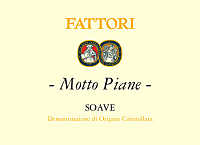
|
|
Soave Motto Piane 2010 |
|
| Fattori (Veneto, Italy) | |
| Grapes: Garganega | |
| Price: € 20.00 | Score: |
| Soave Motto Piane shows an intense golden yellow color and nuances of straw yellow, very transparent. The nose reveals intense, clean, pleasing, refined and elegant aromas which starts with hints of apple, medlar and plum followed by aromas of pineapple, citrus fruits, almond, hawthorn, broom, honey, pear and peach. The mouth has good correspondence to the nose, a crisp attack and however balanced by alcohol, good body, intense flavors, pleasing roundness. The finish is persistent with flavors of apple, peach and medlar. A part of Soave Motto Piane ferments and ages in cask. | |
| Food Match: Pasta and risotto with vegetables and crustaceans, Mushroom soups, Sauteed white meat, Stewed fish | |
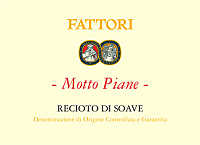
|
|
Recioto di Soave Motto Piane 2009 |
|
| Fattori (Veneto, Italy) | |
| Grapes: Garganega | |
| Price: € 25.00 - 50cl | Score: |
| Recioto di Soave Motto Piane shows a brilliant amber yellow color and nuances of amber yellow, transparent. The nose reveals intense, clean, pleasing, refined and elegant aromas which start with hints of raisin, dried apricot and almond followed by aromas of dried fig, peach jam, quince jam, candied fruits, lychee, vanilla, honey and nail polish. The mouth has good correspondence to the nose, a sweet and round attack, however balanced by alcohol, good body, intense flavors, pleasing crispness. The finish is persistent with flavors of raisin, dried apricot and almond. A part of Recioto di Soave Motto Piane ages in cask for 12 months. | |
| Food Match: Fruit and cream tarts, Hard cheese | |
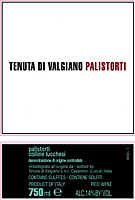
|
|
Colline Lucchesi Rosso Palistorti di Valgiano 2008 |
|
| Tenuta di Valgiano (Tuscany, Italy) | |
| Grapes: Sangiovese (70%), Syrah (15%), Merlot (15%) | |
| Price: € 15.00 | Score: |
| Colline Lucchesi Rosso Palistorti di Valgiano shows an intense ruby red color and nuances of garnet red, little transparency. The nose reveals intense, clean, pleasing and refined aromas that start with hints of black cherry, black currant and plum followed by aromas of violet, chocolate, tobacco, vanilla, raspberry and cinnamon. The mouth has good correspondence to the nose, a tannic attack and however balanced by alcohol, good body, intense flavors, pleasing roundness. The finish is persistent with flavors of black cherry, black currant and plum. Colline Lucchesi Rosso Palistorti di Valgiano ages for 12 months in barrique followed by 6 months of aging in bottle. | |
| Food Match: Broiled meat and barbecue, Roasted meat, Stewed meat, Hard cheese | |
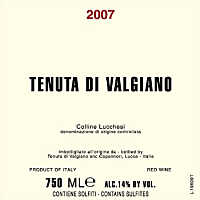
|
|
Colline Lucchesi Rosso Tenuta di Valgiano 2007 |
|
| Tenuta di Valgiano (Tuscany, Italy) | |
| Grapes: Sangiovese (65%), Syrah (20%), Merlot (15%) | |
| Price: € 50.00 | Score: |
| Colline Lucchesi Rosso Tenuta di Valgiano shows an intense ruby red color and nuances of garnet red, little transparency. The nose denotes intense, clean, pleasing and refined aromas which start with hints of black cherry, black currant and plum followed by aromas of blueberry, violet, vanilla, tobacco, chocolate, black pepper and eucalyptus. The mouth has good correspondence to the nose, a tannic attack and however balanced by alcohol, good body, intense flavors, pleasing roundness. The finish is persistent with flavors of black cherry, black currant and plum. Colline Lucchesi Rosso Tenuta di Valgiano ages for 15 months in cask. | |
| Food Match: Roasted meat, Braised and stewed meat, Hard cheese | |
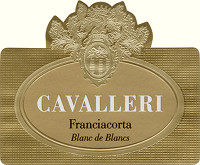
|
|
Franciacorta Brut Blanc de Blancs |
|
| Cavalleri (Lombardy, Italy) | |
| Grapes: Chardonnay | |
| Price: € 21.00 | Score: |
| Franciacorta Brut Blanc de Blancs shows a brilliant straw yellow color and nuances of straw yellow, very transparent, fine and persistent perlage. The nose denotes intense, clean, pleasing and refined aromas that start with hints of apple, plum and bread crust followed by aromas of banana, pear, grapefruit, hawthorn and yeast. The mouth has good correspondence to the nose, an effervescent and crisp attack, however balanced by alcohol, good body, intense flavors, agreeable. The finish is persistent with flavors of apple, banana and grapefruit. Franciacorta Brut Blanc de Blancs referments in bottle on its lees for at least 24 months. | |
| Food Match: Fried fish, Broiled fish, Pasta and risotto with fish and crustaceans | |
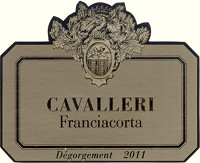
|
|
Franciacorta Pas Dosé Récemment Dégorgé 2006 |
|
| Cavalleri (Lombardy, Italy) | |
| Grapes: Chardonnay | |
| Price: € 26.00 | Score: |
| Franciacorta Pas Dosé Récemment Dégorgé shows an intense straw yellow color and nuances of straw yellow, very transparent, fine and persistent perlage. The nose denotes intense, clean, pleasing, refined and elegant aromas which start with hints of banana, praline and bread crust followed by aromas of apple, yeast, brioche, honey, pear, citrus fruit peel, vanilla and plum. The mouth has good correspondence to the nose, an effervescent and crisp attack, however balanced by alcohol, good body, intense flavors, pleasing roundness. The finish is persistent with flavors of banana, apple and praline. A small part of the base wine ferments in barrique. Franciacorta Pas Dosé Récemment Dégorgé referments in bottle on its lees for at least 48 months. | |
| Food Match: Stuffed pasta, Roasted white meat, Roasted fish, Fish soups | |
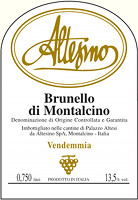
|
|
Brunello di Montalcino 2006 |
|
| Altesino (Tuscany, Italy) | |
| Grapes: Sangiovese | |
| Price: € 30.00 | Score: |
| This Brunello di Montalcino shows a brilliant ruby red color and nuances of brick red, moderate transparency. The nose reveals intense, clean, pleasing and refined aromas which start with hints of plum, black cherry and dried violet followed by aromas of blueberry, raspberry, vanilla, tobacco, mace, chocolate and cinnamon. The mouth has good correspondence to the nose, a tannic attack and however balanced by alcohol, full body, intense flavors, pleasing roundness. The finish is persistent with flavors of plum, black cherry and blueberry. This Brunello di Montalcino ages for at least 2 years in cask. | |
| Food Match: Game, Roasted meat, Braised and stewed meat, Hard cheese | |
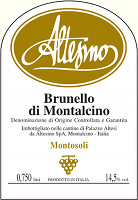
|
|
Brunello di Montalcino Montosoli 2006 |
|
| Altesino (Tuscany, Italy) | |
| Grapes: Sangiovese | |
| Price: € 55.00 | Score: |
| Brunello di Montalcino Montosoli shows a brilliant ruby red color and nuances of brick red, moderate transparency. The nose denotes intense, clean, pleasing, refined and elegant aromas which start with hints of black cherry, violet and plum followed by aromas of blueberry, vanilla, raspberry, cinnamon, chocolate, pink pepper, tobacco, mace and menthol. The mouth has good correspondence to the nose, a tannic attack and however balanced by alcohol, full body, intense flavors, pleasing roundness. The finish is persistent with flavors of black cherry, plum and raspberry. Brunello di Montalcino Montosoli ages for 4 years in cask, 4 months in barrique and 4 months in bottle. | |
| Food Match: Game, Braised and stewed meat, Roasted meat, Hard cheese | |
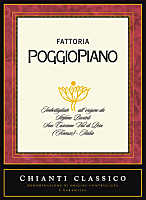
|
|
Chianti Classico 2008 |
|
| Fattoria Poggiopiano (Tuscany, Italy) | |
| Grapes: Sangiovese | |
| Price: € 7.90 | Score: |
| This Chianti Classico shows a brilliant ruby red color and nuances of garnet red, moderate transparency. The nose reveals intense, clean and pleasing aromas which start with hints of black cherry, plum and dried violet followed by aromas of tobacco, vanilla, carob and graphite. The mouth has good correspondence to the nose, a slightly tannic attack and however balanced by alcohol, good body, intense flavors. The finish is persistent with flavors of black cherry, plum and blueberry. This Chianti Classico ages in cask. | |
| Food Match: Pasta with meat, Broiled meat and barbecue, Stewed meat | |
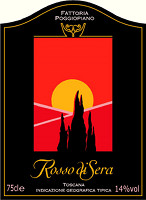
|
|
Rosso di Sera 2008 |
|
| Fattoria Poggiopiano (Tuscany, Italy) | |
| Grapes: Sangiovese (90%), Colorino (10%) | |
| Price: € 22.00 | Score: |
| Rosso di Sera shows a brilliant ruby red color and nuances of garnet red, little transparency. The nose denotes intense, clean, pleasing and refined aromas which start with hints if black cherry, plum and violet followed by aromas of blueberry, vanilla, tobacco, pink pepper, cocoa, leather and clove. The mouth has good correspondence to the nose, a tannic attack and however balanced by alcohol, good body, intense flavors, pleasing roundness. The finish is persistent with flavors of plum, black cherry and blueberry. Rosso di Sera ages for 12 months in barrique followed by 6 months of aging in bottle. | |
| Food Match: Broiled meat and barbecue, Roasted meat, Stewed meat, Hard cheese | |
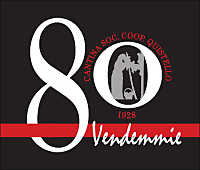
|
|
80 Vendemmie Rosso 2010 |
|
| Cantina di Quistello (Lombardy, Italy) | |
| Grapes: Lambrusco Ruberti | |
| Price: € 5.50 | Score: |
| 80 Vendemmie Rosso shows a deep ruby red color and nuances of purple red, little transparency, fine and persistent perlage. The nose reveals intense, clean and pleasing aromas that start with hints of black cherry, blackberry and plum followed by aromas of blueberry, raspberry and violet. The mouth has good correspondence to the nose, an effervescent and slightly tannic attack, however balanced by alcohol, good body, intense flavors, pleasing crispness. The finish is persistent with flavors of black cherry, blackberry and plum. 80 Vendemmie Rosso referments in bottle. | |
| Food Match: Cold cuts, Pasta with meat, Stewed meat with mushrooms | |
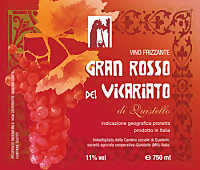
|
|
Gran Rosso del Vicariato di Quistello 2010 |
|
| Cantina di Quistello (Lombardy, Italy) | |
| Grapes: Lambrusco Ruberti, Ancellotta | |
| Price: € 4.00 | Score: |
| Gran Rosso del Vicariato di Quistello shows a deep ruby red color and nuances of purple red, little transparency. The nose denotes intense, clean, pleasing and refined aromas which start with hints of blackberry, cherry and blueberry followed by aromas of raspberry, violet, plum and strawberry. The mouth has good correspondence to the nose, a tannic and effervescent attack, however balanced by alcohol, good body, intense flavors, pleasing crispness. The finish is persistent with flavors of blackberry, cherry and blueberry. Gran Rosso del Vicariato di Quistello referments in bottle. | |
| Food Match: Cold cuts, Stuffed pasta, Stewed meat, Cheese | |

|
|
Valdadige Terradeiforti Enantio 2005 |
|
| Letrari (Trentino, Italy) | |
| Grapes: Enantio | |
| Price: € 24.75 | Score: |
| Valdadige Terradeiforti Enantio shows a deep ruby red color and nuances of garnet red, little transparency. The nose denotes intense, clean, pleasing, refined and elegant aromas which start with hints of plum, black cherry and blueberry followed by aromas dried violet, rhubarb, vanilla, blackberry, tobacco, licorice, cocoa and menthol. The mouth has good correspondence to the nose, a tannic attack and pleasing crispness, however balanced by alcohol, full body, intense flavors, pleasing roundness. The finish is persistent with flavors of plum, black cherry and blueberry. | |
| Food Match: Game, Roasted meat, Stewed and braised meat with mushrooms, Hard cheese | |

|
|
Trento Talento Brut 976 Riserva del Fondatore 2000 |
|
| Letrari (Trentino, Italy) | |
| Grapes: Chardonnay (50%), Pinot Noir (50%) | |
| Price: € 52.50 | Score: |
| Trento Talento Brut 976 Riserva del Fondatore shows a brilliant golden yellow color and nuances of straw yellow, very transparent, fine and persistent perlage. The nose reveals intense, clean, pleasing, refined and elegant aromas that start with hints of banana, apple and bread crust followed by aromas of grapefruit, plum, hazelnut, honey, citrus fruit peel, yeast, butter and hawthorn. The mouth has good correspondence to the nose, an effervescent and crisp attack, however balanced by alcohol, good body, intense flavors, pleasing roundness. The finish is persistent with flavors of banana, apple and hazelnut. Trento Talento Brut 976 Riserva del Fondatore referments in bottle on its lees for at least 90 months. | |
| Food Match: Roasted fish, Roasted white meat, Stuffed pasta | |
|
||||||||
|
DiWineTaste Polls
|
| |||||||
Privacy Policy | |||||||


| Copyright © 2002-2024 Antonello Biancalana, DiWineTaste - All rights reserved |
| All rights reserved under international copyright conventions. No part of this publication and of this WEB site may be
reproduced or utilized in any form or by any means, electronic or mechanical, without permission in writing from DiWineTaste. |